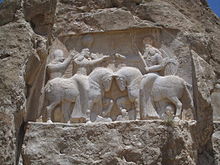Persis
Persis
Περσίς Persís | |
|---|---|
Region | |
 The Persian Empire, about 500 BC; Persis is the central southern province with the red outline. Its main cities are Persepolis and Pasargadae. |
Persis (
Achaemenid Empire
The ancient
Alexandrian Empire
The Achaemenid Empire was defeated by Alexander the Great in 330 BC, incorporating most of their vast empire.
Several Hellenistic satraps of Persis are known (following the conquests of Alexander the Great) from circa 330 BC, especially
Seleucid Empire
When the
- "Frataraka" Governors of the Seleucid Empire
Several later Persian rulers, forming the
Kings of Persis, under the Parthian Empire
During an apparent transitional period, corresponding to the reigns of Vādfradād II and another uncertain king, no titles of authority appeared on the reverse of their coins. The earlier title prtrk' zy alhaya (
When the
Sasanian Empire

Babak was the ruler of a small town called Kheir. Babak's efforts in gaining local power at the time escaped the attention of
The subsequent events are unclear, due to the sketchy nature of the sources. It is however certain that following the death of Babak around 220, Ardashir who at the time was the governor of Darabgird, got involved in a power struggle of his own with his elder brother Shapur. The sources tell us that in 222, Shapur was killed when the roof of a building collapsed on him.
Ardaxšir (Artaxerxes) V, defeated the last legitimate Parthian king,
At this point, Ardashir moved his capital further to the south of Persis and founded a capital at Ardashir-Khwarrah (formerly Gur, modern day

Artabanus marched a second time against Ardashir I in 224. Their armies clashed at
The Sassanids ruled for 425 years, until the Muslim armies conquered the empire. Afterward, the Persians started to convert to Islam, this making it much easier for the new Muslim empire to continue the expansion of Islam.
Persis then passed hand to hand through numerous dynasties, leaving behind numerous historical and ancient monuments; each of which has its own values as a world heritage, reflecting the history of the province,
See also
- Fars Province
- Pars (Sasanian province)
- Persian Gulf
- Fars (territory)
References
- ISBN 9783406093975.
- ^ ISBN 9780521611916.
- ^ "cylinder seal | British Museum". The British Museum.
- ^ "Darius' seal, photo - Livius". www.livius.org.
- ISBN 978-0-8160-5722-1.)
{{cite book}}: CS1 maint: multiple names: authors list (link - ISBN 9789004217553.
- ^ ISBN 9780857710185.
- ^ a b c Foundation, Encyclopaedia Iranica. "Welcome to Encyclopaedia Iranica". iranicaonline.org.
- ^ "CNG: Feature Auction CNG 96. KINGS of PERSIS. Vādfradād (Autophradates) I. 3rd century BC. AR Tetradrachm (28mm, 15.89 g, 9h). Istakhr (Persepolis) mint". www.cngcoins.com.
- ^ The Cambridge History of Iran, Vol. 3 (1), p. 299
- ^ a b FRATARAKA – Encyclopaedia Iranica.
- ^ a b "CNG: Feature Auction CNG 90. KINGS of PERSIS. Vahbarz (Oborzos). 3rd century BC. AR Obol (10mm, 0.50 g, 11h)". www.cngcoins.com.
- ^ The Cambridge History of Iran, Vol. 3 (1), p. 302
- ISBN 9781846031083.
